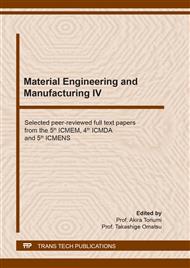[1]
S. Weiner and H.D. Wagner: Annu. Rev. Mater. Sci. Vol. 28 (1998), p.271–298.
Google Scholar
[2]
J.A. PETRUSKA and A.J. HODGE: Proc. Natl. Acad. Sci. Vol. 51 (1964), p.871–876.
Google Scholar
[3]
J.W. Smith: Nature Vol. 219 (1968), p.157–158.
Google Scholar
[4]
M. Kikuchi, S. Itoh, S. Ichinose, and K. Shinomiya: Biomaterials Vol. 22 (2001), p.1705–1711.
Google Scholar
[5]
Y. Chai, M. Okuda, Y. Otsuka, K. Ohnuma, and M. Tagaya: Adv. Powder Technol. Vol. 30 (2019), p.1419–1423.
Google Scholar
[6]
J.H. Bradt, M. Mertig, A. Teresiak, and W. Pompe: Chem. Mater. Vol. 11 (1999), p.2694–2701.
DOI: 10.1021/cm991002p
Google Scholar
[7]
T. Kokubo, H. Kushitani, S. Sakka, T. Kitsugi, and T. Yamamuro: J. Biomed. Mater. Res. Vol. 24 (1990), p.721–734.
DOI: 10.1002/jbm.820240607
Google Scholar
[8]
Y. Chai, T. Yamaguchi, and M. Tagaya: Cryst. Growth Des. Vol. 17 (2017), p.4977–4983.
Google Scholar
[9]
Y. Chai, S. Yamada, K. Kobayashi, K. Hasegawa, and M. Tagaya: Microporous Mesoporous Mater Vol. 286 (2019), p.1–8.
Google Scholar
[10]
N.A.J.M. van Aerle and A.J.W. Tol: Macromolecules, Vol. 27 (1994), p.6520–6526.
Google Scholar
[11]
T. Manaka, K. Taguchi, K. Ishikawa, and H. Takezoe: Japanese J. Appl. Physics, Part 1 Regul. Pap. Short Notes Rev. Pap. Vol. 39 (2000), p.4910–4911.
Google Scholar
[12]
H. Yu, J. Li, T. Ikeda, and T. Iyoda: Adv. Mater. Vol. 18 (2006), p.2213–2215.
Google Scholar
[13]
H. Miyata and K. Kuroda: Chem. Mater. Vol. 11 (1999), p.1609–1614.
Google Scholar
[14]
M. Thuanthong, N. Sirinupong, and W. Youravong: J. Sci. Food Agric. Vol. 96 (2016), p.3795–3800.
Google Scholar
[15]
P. Noitup, M.T. Morrissey, and W. Garnjanagoonchorn: J. Food Biochem. Vol. 30 (2006), p.547–555.
Google Scholar
[16]
T. Matsunobe, N. Nagai, R. Kamoto, Y. Nakagawa, and H. Ishida: J. Photopolym. Sci. Technol. Vol. 8 (1995), p.263–268.
Google Scholar
[17]
H. Deligöz, S. Özgümüş, T. Yalçinyuva, S. Yildirim, D. Deǧer, and K. Ulutaş: Polymer Vol. 46 (2005), p.3720–3729.
DOI: 10.1016/j.polymer.2005.02.097
Google Scholar
[18]
S.H. Xie, B.K. Zhu, X.Z. Wei, Z.K. Xu, and Y.Y. Xu: Compos. Part A Appl. Sci. Manuf. Vol. 36 (2005), pp.1152-1157.
Google Scholar
[19]
L.L. Fernandes, C.X. Resende, D.S. Tavares, G.A. Soares, L.O. Castro, and J.M. Granjeiro: Polimeros Vol. 21 (2011), p.1–6.
Google Scholar
[20]
P. Kittiphattanabawon, S. Nalinanon, S. Benjakul, and H. Kishimura: J. Chem. Vol. 2015 (2015).
Google Scholar
[21]
B. De Campos Vidal and M.L.S. Mello: Micron Vol. 42 (2011), p.283–289.
Google Scholar


